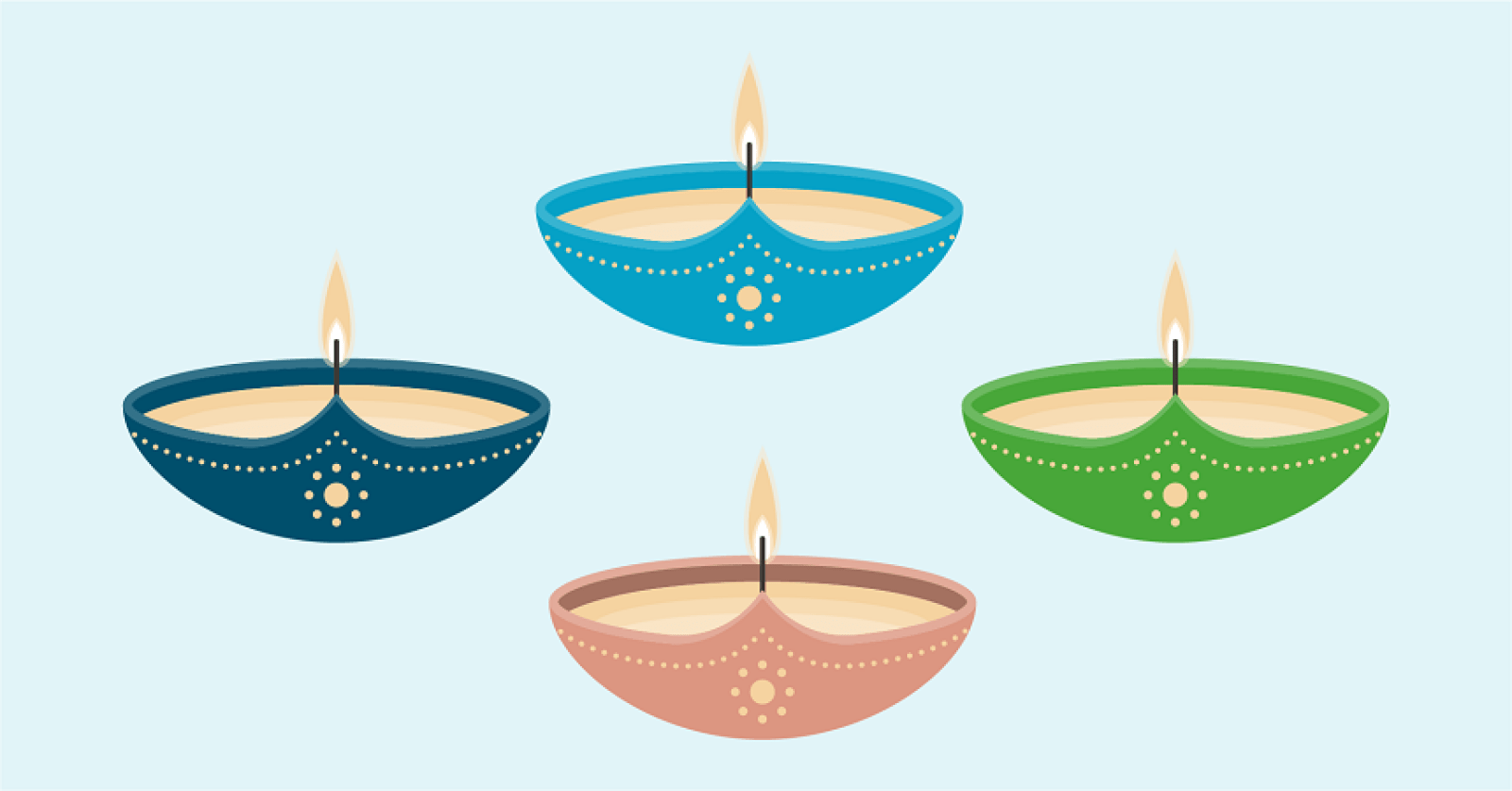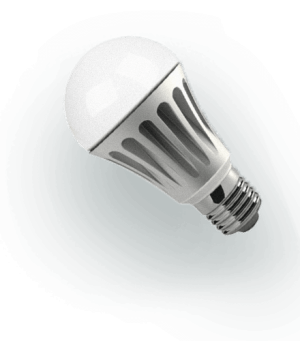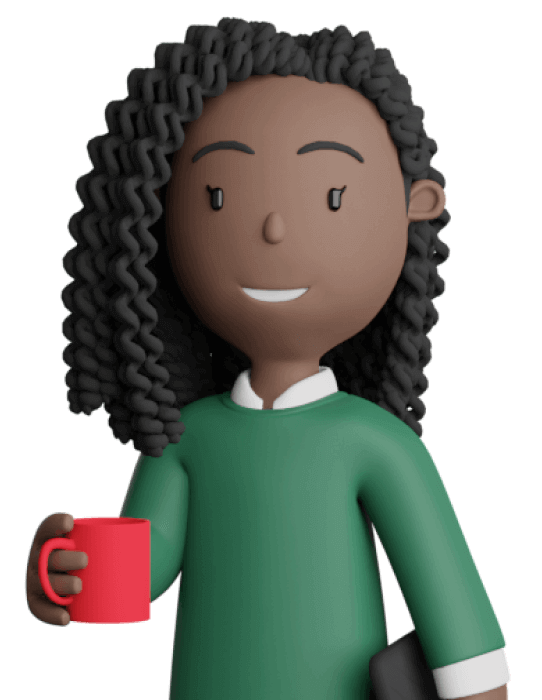Diwali and Deepavali: Festival of lights
A hands-on STEAM activity to learn about the many uses of light.

Overview
Learn about Diwali and Deepavali: Festival of lights, by crafting a diya.
Instructions
What you'll need
- Diya instructions and template:
- K to grade 1
- Grade 2 to 3
- Glue stick or liquid glue, 1 per student
- Scissors, 1 per student
Teacher prep
- Cut strips of colourful paper (7cm x 30cm each), 1 per student.
Note: If there's extra material, ask students to make more than 1 diya. If students are done early, ask them to help another student.
Optional: Use a laptop and projector to view the videos.
- Diwali introduction video (source: kSmart: Kids Fun Learning Channel!)
- Ramayana: Story of Diwali (source: MocomiKids)
- Paper diya video (source: Siri craft !deas)
- Start a brainstorm discussion. Ask students to think of words that come to mind when they think of “celebrations”. Ask students to share their ideas with the class by raising their hands. Some examples may include: family, friends, tradition, food, decorations, gifts, special clothes, and lights.
- Lead students into mentioning decorations or lights during the brainstorm activity. Ask students to share different ways they use lights during celebrations in their culture. Example: decorating the house or Christmas tree with lights, lighting birthday candles on a cake etc.
- People celebrate in different ways all around the world. Even though cultures are different, there are also many similarities.
- Diwali and Deepavali festival is India’s biggest holiday of the year. It's known as the "Festival of Lights." Optional: show students this video to introduce them to Diwali.
- It takes place every year around late October or Early November.
- Traditionally, people decorate their homes with diyas, which are special clay lamps.
- Family and friends get together, give gifts, and share food.
Option 1: Read Aunty Penelope’s story about how she celebrated Deepavali/Diwali with her family for the past 50 years.
“Early Deepavali day, my family and I wake up at 5am to cook tosai, vadai and other treats. We always made odd numbers of treats because we believed it would bring us happy occasions. We put the offerings on a tray and place it on the altar for the deities and gods. Then we showered, prayed individually, and changed into our new clothes that we bought a few days ago. We greeted each other with “Happy Deepavali/Diwali”. I cooked tosai, curries, and dhal and we would all have breakfast together, laughing and chatting. After breakfast, it’s time for lunch, and families would come over to our place for a visit and a feast. We lit lamps to make our homes bright. We celebrated for five days.”
- Did you know that there are solar-powered diya lamps? In an effort to move towards sustainability, solar diya lamps were developed by Chetan Singh Solanki, a professor in IIT-Bombay, India. Solar diya lamps are meant to spread a message about climate change and impacts from using fossil fuels for energy. There are many faith leaders who are advocating for the benefits of solar energy, including promoting the use of solar powered diya lamps.
Option 2: Show the following video of the story of Diwali and why this festival is celebrated. Video: Ramayan: Story of Diwali.
Each student will have the chance to make their own diya! The teacher will show the pre-made example and pass it around the class. You can show the video instructions on the board.
Diya instructions (K-grade 1)
- Photocopy the diya template. (1 per student)
- Photocopy sheet of the flame cut out. (1 flame per diya template)
- Ask students to colour in the template and flame.
- Cut the diya and flame out.
- Glue the flame onto the diya.
Diya instructions (Grade 2-3)
- Distribute strips of pre-cut coloured paper. Give students options and allow them to choose the colour they like best.
- Distribute 1 page of “flame” cut outs per group.
- Fold the coloured strip of paper in half.
- Open the strip of paper and fold it into an accordion pattern as shown in this video.
- After folding an accordion pattern, glue the folds together as shown so that it creates a “fan” shape. For visual reference, please see this video (1:30 minute)
- Allow the glue to dry.
Have students colour the flame shape yellow. Cut out the flame and glue it onto the diya as shown. For reference, you can view this video (2:54 minute).
Modify or extend this activity
- Make a class diya display. Ask students to attach their diyas in an area in the classroom or hallway (bulletin board, wall, door, window, etc). For reference, watch this video for some display ideas for your classroom.
- Think about ways that light is used during your family’s celebrations.
- Make groups of 4. Ask students to talk about the different ways lights are used for celebrations in their own family within their groups.
- Distribute 1 sheet of paper per student and ask students to draw pictures of how they celebrate with lights and their loved ones in their culture.
- After the drawing session is complete, ask students to volunteer to share their experiences with the class. Encourage students who are listening to ask follow-up questions to learn more about their classmate’s culture. Ask students to compare their celebrations with Diwali. Talk about similarities and differences.
Curriculum Fit
Learning objectives
- Students gain knowledge and understanding of the significance of Diwali or Deepavali.
- Students learn about cultural diversity, including language, stories, and heritages.
- Students learn about the value of diversity which translates to respect, tolerance, and inclusion.
- Students learn about interconnections and aspects of life shared by, and common to, peoples and cultures.
Curriculum fit
Learning about different cultures and how each culture uniquely celebrates important events throughout the year creates bridges between different communities in the school. Learning about other cultures cultivates mutual respect and understanding of different worldviews.
Core competencies
Social Studies: Personal and Social, Thinking
- Understanding relationships and cultural contexts.
- Building relationships.
- Contributing to the community and caring for the environment.
- Reflecting and assessing.
Big ideas
- Our communities are diverse and made of individuals who have a lot in common.
- Healthy communities recognize and respect the diversity of individuals and care for the local environment.
- Canada is made up of many diverse regions and communities.
- People from diverse cultures and societies share some common experiences and aspects of life.
Curricular competencies
- Use Social Studies inquiry processes and skills to ask questions; gather, interpret, and analyze ideas; and communicate findings and decisions.
- Contribute to a class collection of information on a common topic.
- Collect information from personal experiences, oral sources, and visual representations.
- Explain the significance of personal or local events, objects, people, or places.
- Research the history of a significant event or person in the history of your community.
- Explore different perspectives on people, places, issues, or events in their lives (perspective)
- Explain why peoples’ beliefs, values, worldviews, experiences, and roles give them different perspectives on people, places, issues, or events.
Assessments
- Assess students' ability to share new ideas, stories, and vocabulary.
- Assess students’ ability to share relevant and culturally connected stories with peers.
- Have students ask each other questions about their story and assess comprehension of stories.
Teaching Notes
What is Diwali or Deepavali?
- Diwali or Deepavali are two names for the same Hindu festival marking the celebration of victory of light over darkness and good over evil.
- Deepavali originates from the Sanskrit words “deepa” (light) and “avali” (row) and is the celebration of lighting rows of lamps during the festival.
- Although the names are different, the festival and customs are similar, such as cleaning homes, exchanging gifts, feasting, and lighting of lamps.
- Diwali and Deepavali are India’s biggest holiday of the year. It is also known as the Festival of Lights.
When does Diwali and Deepavali take place?
- It takes place around mid-October or early November and follows the lunar calendar. Diwali/Deepavali is celebrated on a new-moon day.
- Diwali is a five-day festival and mostly in north Indian states, where Deepavali is a four-day festival celebrated mostly by southern Indian states.
Who celebrates Diwali and Deepavali?
- Diwali and Deepavali are celebrated by people who practice Hinduism, Jainism, and Sikhism in India and in different parts of the world.
What do people do on Diwali and Deepavali?
- Traditionally, this festival is a time for families to get together, exchange gifts, and share food. Clay lamps called diyas are lit with ceremony using oil or ghee.
- During the festival, there are lots of lights, Kolam (art of Rangoli; intricate designs made with rice powder, limestone, and red brick powder), murukku (treats), open houses, gifts of money, and cookies.
- Diwali and Deepavali are about new beginnings and new light.
The following story shares how one primary teacher celebrates this festival with her students:
Deepavali Delights: Celebrating the Festival of Lights at our school.
A story by Ms. Silvakumari, Early Childhood Educator >40 years and Ms. Juita, niece of Ms. Silvakumari.
“In our multicultural school, teachers of Indian heritage introduced students to Deepavali (Diwali), the Festival of Lights, symbolizing the triumph of light over darkness and good over evil.
We shared the epic tale of Lord Rama's battle to rescue his wife, Sita, from the demon king, Ravana, where rows of oil lamps were lit to celebrate Lord Rama’s victorious return. Our students eagerly participated in the tradition of creating 'Kolams,' intricate rice grain designs adorned with small clay oil lamps (diyas) which symbolize this triumph of light over darkness. Kolams also serve as an appreciation of nature, offering sustenance to birds and ants after the festival. With my students, I embarked on a colorful and creative adventure. We began by preparing various shades of rice using food coloring, and then we laid them out under the warm sun to dry. We carefully transferred a stunning Kolam peacock design onto the floor. Seated in a circle, we each took our turn, adding the different colored rice to the peacock design. Green, turquoise, blue, and gold were carefully placed to create the magnificent tail feathers. The body and head emerged, a beautiful combination of light and dark green and blue.
Students donned colorful traditional Indian attire like sarees, lehengas, and jippas, while a delicious feast featured Indian treats such as murukku, curries, dhal, vada, and dosa. The experience was enriched by Bharatanatyam dances, classical Indian music, and more cultural insights.
The students enjoyed this memorable event, fostering a deeper appreciation for diversity and respect for tradition.”
What and who
Bharatanatyam | Bharatanatyam is an Indian classical dance form that originated in Tamil Nadu, a state in South India. The name "Bharatanatyam" is comprised of four Tamil words: "bhavam" (expression), "ragam" (melody), "thalam" (rhythm), and "natyam" (dance). |
Dhal | Dhal is a fundamental ingredient in Indian cuisine and plays a central role in many traditional dishes such as dhal curry, a flavorful and nutritious lentil soup. |
Jippa | Jippa are traditional Indian men’s one-piece shirts that often go to the knees. |
Kolam | Kolam, also known as Muggu, Tarai Alangaram, or Rangoli, is a traditional form of decorative art practiced in India. |
Lehenga | A Lehenga, also spelled as lengha or langa, is a traditional ankle-length skirt. It is a popular attire choice for various occasions, including weddings, festivals, and special events. |
Lord Rama | Lord Rama is a prominent figure in Hindu mythology and is considered the seventh incarnation of Lord Vishnu, one of the principal deities in Hinduism. |
Murukku | Murukku is a savory and crunchy snack that originates from the Indian subcontinent, particularly popular in South India. The name "murukku" is derived from the Tamil word for "twisted", which describes its distinctive spiral shape. |
Sita | Sita is known for her unwavering devotion and purity. She is abducted by Ravana, leading to Rama's quest to rescue her. |
Vada | Vada is a category of savory fried snack that originates from South India. These snacks can be described in various ways, such as fritters, cutlets, or dumplings. Vadas are typically made from a mixture of lentils and spices, and they are deep-fried to a crispy, golden brown texture. |







